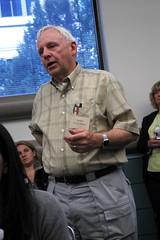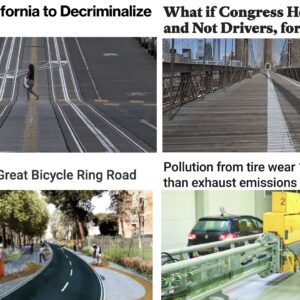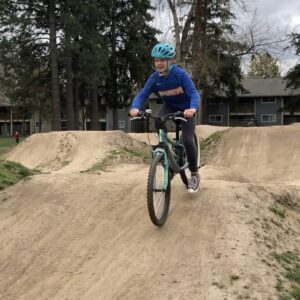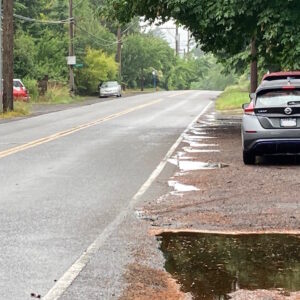Local newspaper, The Southwest Community Connection reports that the Hillsdale Neighborhood Association is in unanimous support of building a cycle track on Capitol Highway.
In their “Government Beat” column published Sunday, the paper wrote:
Don Baack, president of the Neighborhood Association, said the project is a long way off from reality but that it was important for the neighborhood to throw its hat in the ring early.
“It’s going to take some pushing to make that happen,” Baack said.
A cycle track is a lane for bikes that is physically separated from motor vehicle traffic. The Portland Bureau of Transportation will build the city’s first cycle track on NE Cully Boulevard and plans are in the works for a “high-profile” cycle track to be built in downtown Portland (most likely) as per Mayor Adams’ “100 Day Plan”.
City bike coordinator Roger Geller told the Southwest Community Connection that PBOT is “looking at cycle tracks for really all of our shopping areas in the city,” but that the “idea will take time to garner the necessary support.”
Building cycle tracks will also take money, something bike projects have had a hard time coming by in the past.
Read the full article here.






I think this is great. But something really needs to be done with Barbur.
I totally agree that Barbur needs to be a priority.
Agreed on Barbur. It’s a major connection for bikers between SW and downtown, and it’s pretty unpleasant / scary to bike on as is.
I compute on Capitol highway and see maybe 1 or 2 riders each day. I would love it but it is not a high priority. Beaverton Hillsdale would be a much bigger priority since it much more unsafe and would have a lot more cyclists if they felt safer riding on it.
all four posters are 100 percent correct!
It’s pretty much that whole route: Beaverton Hillsdale Hwy.->Capitol Hwy.-> Barbur Blvd. I sometimes take Terwilliger even though it means more climbing because Barbur has some dangerous merges. Any improvemnets along that route would be greatly appreciated.
How about maintaining what we have, first? Get the branches that are partially blocking the bike lane at 39th and Beaverton-Hillsdale removed. Then sweep up the remaining gravel in the bike lanes.
Then fix crash corner, where Beaverton-Hillsdale, Oleson, and Scholls intersect.
Then, fix Barbur: widen the bridges, and add a shoulder westbound just before the Safeway, so that the bike lanes are continuous.
By then, someone else will have gotten one of these cycle tracks.
Bicyclists will all have discovered that the City, which takes too long to street sweep the bike lanes, doesn’t street sweep the cycle tracks at all.
Bicyclists will also quickly discover that the cycle tracks are accidents waiting to happen at intersections, because the cycle track cross streets way before the actual intersection with the other street. So cars will come to a halt for the cross street, not the cycle track. OR, to prevent that sort of accident, traffic engineers will put stop signs each time a cycle track crosses a street, or a driveway, just like they did on the grade separated bike path on Oleson, or the grade separated bike path near Tenino on the STP.
Bicyclists will also discover that the cycle tracks have become the hangout of dog walkers, roller skaters, and tables for restaurants that want outdoor seating.
Bicyclists, rather than the neighborhood assocations, will then decide that therefore cycle tracks are a bad idea, and we won’t get one for Capitol.
Be REALLY careful about the intersections. Separation is a pretty word but its often an illusion.
Yes, the lively discussion of deaths along European radwegen is about just this point (#7 and #8). The track crosses at a distance from the actual intersection. Cyclists who don’t plan ahead for the crossing, or perhaps who are asserting a right they have, get nailed by a really fast car, not one that is almost stopped. In Europe the experience is that the tracks, of which there are thousands of km, are excellent in rural stretches. Cyclists don’t get doored, rear-ended, side-swiped. Nice. All the fatalities happen at crossings.
Seth #7 has it correct.
A few areas elsewhere might benefit from a cycle track but none of those listed would be on my list [as a daily commuter from just beyond that area]. Let someone else be first with the fancy design.
Look how autos treat the sidewalks and bike lanes through Hillsdale right now; not to mention the speed has been reduced to 25 through most that area and very few go near that rate.
If cycle tracks will be going in all of our commercial districts I guess we shouldn’t have built all those curb extensions first, as they were expensive and are going to have to be removed to accommodate the cycle tracks.
Question for Roger: does this include such streets as Hawthorne, Division and Woodstock, or is this really all just smoke and mirrors?
I think that this is a great example of the city of Portland trying to, “do good by cyclists,” but not actually caring.
Seems like it would behoove Portland to ask which streets we commute on then build bike boulevards from there. Sure, more cycle tracks are always good. But how about some we’ll use more? Like, oh, I dunno, 7th ave in SE? Or maybe, NE Broadway. Interstate ave? Perhaps even something crazy like Hawthorne?
Maybe I’m totally off base here, but these two cycle tracks they’re building could be put to better use.
A cycle track on the eastside might get more traffic, but something needs to be a priority around the West Hills.
Maybe not Capitol (except between Barbur and BH), but Barbur to Beaverton- Hillsdale would be very useful. (ODOT?) Its the smallest climb between Beaverton and Portland, but traffic can be heavy in places and there is still gravel in some of the more demanding corners (down hill, east of Sunset).
“Cycle Tracks” along long stretches of highway with no intersections = awesome.
“Cycle Tracks” along busy grid streets with lots of intersections = death trap.
Just like bikes aren’t always the answer to transportation problems, cycle tracks aren’t always the answer to cycling problems.
If cycle tracks start popping up everywhere, it will require lots of motorist education to teach drivers how to behave around such tracks, i.e., how to drive when there is the potential for bikes to be present. The same kind of education is already necessary; lots of drivers don’t know how to behave around bikes. Will having a cycle track make this kind of education easier? A cycle track might be more high-profile (no pun intended) so as to raise awareness of drivers, but a cycle track will be no more intuitive for drivers to figure out than a painted bike lane–or simply a cyclist’s presence.
At the same time, if cyclists are forced to use cycle tracks on anything other than highways (Oregon already has mandatory use laws which would conceivably apply to cycle tracks) it has the potential for decreasing the convenience, efficiency, and even safety (despite the false perception of increased safety) of cycling (for many of the reasons already cited above in, e.g., #7).
So, if driver education/cultural change will be needed in either case–tracks or no tracks, and cyclist convenience, efficiency and safety are all potentially negatively impacted by having tracks, why, oh why do we want them anywhere along the surface street grid? Why not just concentrate on the education that will be necessary regardless? Spend any money that would go to cycle tracks on improved, more “shareable” street design.
If we want to build cycle tracks, they should be along routes that are not frequently intersected by motor routes. I wish there was a map of where this proposed track would go; it actually sounds like it would be an appropriate route that would make traversing the area by bike easier and safer. However, cycle tracks should not be considered a panacea for all cycling woes.
It is great to see U.S. cities begin to explore cycle tracks!
Cycle tracks… YES!
Next Powell, and Broadway, and 39th and 82nd and on and on and on….
So, after re-reading some of the above comments , # 7 and #14 in particular I just have to ask: have any of the folks who are opposed to cycle tracks actually ever used one?
I have. So let me tell you how they work.
Motorist’s stopping point must be before the track crossing, not at the intersection as it is now. That’s a good thing. It move bike safety to the #1 seat over motorist convenience where it is now.
Yes, there will need to be re-education for motorists and cyclists, that’s good.
Cycle tracks actually make biking easier, safer and more convenient, regardless of above conjecture.
Cyclists are separated from motor traffic. This not only increase the perception that biking is safe, and increases the # of people who are biking. It also make the cyclist more visible to parallel motor traffic. Think about it. What is easier to see in your peripheral vision: an item one foot from your shoulder or an item 6-8 ft from your shoulder?
I do agree there are better, more deserving locations than Capital HWY or Cully Blvd. but hey, we have to start somewhere…
Who is making some of these decisions? I don’t thinkthey are people who ride bikes! Who needs a cycle track on Cully? These are political decisions made by politicians who are wasting money on projects that cyclists don’t care about. A few weeks ago there was a blurb about spending money to put a bike lane on scholls ferry from beaverton hillsdale to highway 26. What commuter cyclist wants to ride that route? We can’t waste political capital on stupid projects like these.
Fixing the “holes” in the current road/bike system would get us farther along. Barbur to Hillsdale without going around by Fred Meyer would help. Eliminating the pinch points where the bike lane ends farther south by Safeway is important. BHH to Beaverton west of Raleigh Hills would be fantastic. These are critical areas that need solutions in SW before a bike only road is built.
Tbird –
Perhaps I have seen too many of the half-[baked] “solutions” to some bike routing problems in the area and wonder how well-designed a Portland cycle track would be. One of my biggest concerns would be right-turning traffic at an intersection with a cycle track where cyclists are going straight. The solution to that seems to be separate signals for bikers and drivers; are such signals in the budget for cycle track construction? In your experience, how much time does having separate signals add to the light cycle? The other change at these intersections would have to be no right on red, so drivers aren’t tempted to creep across the cycle track to make such a turn. Assuming the problems at proper intersections can be (and have been, in other cities) solved with the right mix of design, signaling and driver/rider compliance, what are the rules for cycle tracks that cross driveways? When exiting the driveway, do drivers stop once for bikes, then creep across and block the cycle track while they wait for auto traffic to clear? What about when entering a driveway?
In the places where you have used cycle tracks, are there rules in place about pedestrian use of the tracks? Are cycle tracks just that–tracks for the exclusive use of cycles? Or would they evolve into extra-fancy MUPs? If I am riding on a raised cycle track and a delivery truck decides to back up onto it and park for a while (not far-fetched), do I have to hop a curb to get around it? I know cyclists are never supposed to be in a hurry, but what if I feel like passing a slower rider–is there room?
The other question I have about cycle tracks concerns left turns. Again, in your experience, how are left turns made from a cycle track? Always using the “pedestrian” method? By going a block past the desired turn and making a clockwise loop back around the block? Are there ever places along the track where a rider can merge into the street to make a left?
I guess maybe the root of my concern is a fear of being trapped. On a cycle track, I can’t merge over into the line of traffic to avoid being right-hooked. I can’t maneuver out around the obstacles that would inevitably block a track at times. If a track is covered with wet leaves or snow, I can’t just move over into the the tire-swept auto lane for a block or two. I can’t just signal and move over to make a left turn. If I need to make an emergency turn to avoid being hit, will there be enough of a radius to turn from a track onto a cross street? How will drivers/law enforcement feel if I am riding in the street when there is a cycle track right next to me?
Over in the comments on the article about the proposed Cully cycle track, “Scott”, who claims to live and bike in Copenhagen, makes a statement that I think is the key to the whole thing (emphasis mine):
“What makes the cycling environment [in Copenhagen] so amazing is the unanimous acceptance of the bicycle.”
Until that happens here, infrastructure improvements will only go a short way toward better cycling.
Tbird #17
Thanks for the insight. I don’t think I am necessarily against the idea of a cycle track per se…more of the fact that people want them because they are 1) cool and 2) love the ‘concept’ of separation [see also points made in 18 and 12].
I also don’t like the idea of trying to ‘improve’ an existing system that works. There are many more priorities for basic infrastructure out there. I can see planning it in a new development or a major overhaul of the Hillsdale shopping area but it really isn’t worth the effort and money in a retrofit situation [IMO]. Hillsdale works fine – the bigger issue is lack of consistent continuity to surrounding areas with systems in place [see many of the west side points above; also the east side pinches].
People in their cars in the US like consistency and ease – keep to the basics and work to improve and maintain that until such time that serious holes no longer exist.
Honestly, I ride all over and find very few problems that cannot be dealt with.
we shouldn’t be building any cycle tracks in Portland until the state mandatory side path / bike lane laws are repealed. Nary a peep from the city or the BTA on this, though.
El B-
I hear ya on the Portland designed track concerns. My opinion is that we will try to “Portland-ize” it, by re-designing the track instead of copying an already functioning model.
That being said, follow this link:
http://tinyurl.com/bl4ylq
This is an intersection just around the corner from my old apartment. I’ve ridden thru here 1000’s of times. NEVER have I seen a right hook, not even close. There is a slight delay in the auto signal, but only few seconds. Note that cyclists stop well forward of the stop point for motorists, effectively creating a bike box situation. Yes, there is no right on red. The rules for cycle tracks crossing driveways are simple: Bikes have right of way over ALL intersecting traffic, streets and driveways alike. The difference is that in the Netherlands, there are few private driveways, but plenty of crossing streets.
Pedestrians may use cycle tracks at their own peril. In other words it’s a bike track only…The separation of the track from the street insures that delivery vehicle rarely if ever block the track. There is a large berm preventing vehicles from easily crossing the track.
As for left turns: that’s simple. Look at the image above. Cross the intersection, pause and wait for the signal allowing you to proceed onto the next street. Never do you need to merge into auto traffic. That’s the point of being separate. Don’t let your current strategies for dealing with traffic cloud your perception. This is a very simple and effective solution to high auto/bike traffic situations. You won’t be dealing with traffic in the same manner…
All of these designs lead to the idea of ‘universal acceptance’ of the bicycle by placing the bikers right of way above all other vehicles. The ideas above may seem foreign, but we can’t expect only organic growth to bring biking to this level, we also need some ideas forced upon the infrastructure system to jump start the growth.
For the record, I am TOTALLY for the mandatory side path law, if it really exists, but we actually need to look at bikes as transport vehicles, not an extension of our egos. In other words, for this to work we need to stop zipping around everywhere and follow the roadway guidelines laid out by the cycle track/ bike lanes…but these infrastructure must also be properly designed, not just a line in the gutter. In my experience bike friendly doesn’t mean bikes get to do anything, anywhere at anytime. It means there are functioning infrastructure systems combined with laws and ENFORCEMENT that create a safe environment for EVERYONE to cycle. For folks like you or I riding in heavy traffic is probably OK. These systems will entice my 65 yr old Mother, or 7 yr old Nephew to feel safe riding around the city…Currently that’s not always the case.
Sorry for the length of this comment, I could go on with more points, but I will spare you for now..;)
Tbird–
Thanks for the map link and further explanations. I think we disagree on the mandatory sidepath law, but that may be just because, as you note, a lot of the sidepaths/bike lanes around here bite (sometimes literally…). I could get behind something like you point to as a solution to intersection navigation at busy intersections (even though I have an irrational dislike for the two-point left turn), but I still think it is a matter of using appropriate infrastructure for the location.
Psychology of change is a weird thing. You are correct to point out that my current traffic strategies color my perception of how something totally new and different might work. I also have concerns about how the addition of admittedly nice, but limited infrastructure would affect the psychology of drivers. There are already many (as evidenced by comments on articles from other publications) who believe that if there is no bike lane painted, cyclists are de facto banned from such roads, and anyone riding a bike there is breaking the law and deserves any trouble/injury/death that might result. Part of my fear (this is not to argue for or against anything, but just to explain my vague feeling of unease) is based on this flawed notion of drivers and how it might be amplified by the provision of even higher-profile “bike paths”. I want to avoid anything that makes cyclists appear to be second-class road citizens, and also anything that restricts my freedom to travel (lawfully) by bike wherever I might need to go.
I love it when so-called liberals like T-bird support things like mandatory side path laws for cyclists. The hypocrisy and the irony of this admission are simply astounding.